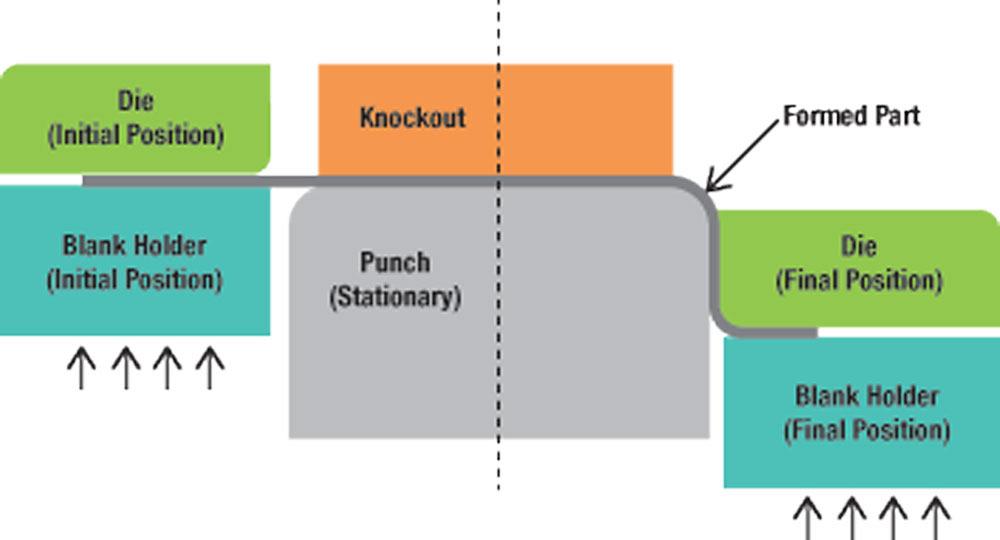Graduate Research Associate - Center for Precision Forming
- FMA
- The Fabricator
- FABTECH
- Canadian Metalworking
Categories
- Additive Manufacturing
- Aluminum Welding
- Arc Welding
- Assembly and Joining
- Automation and Robotics
- Bending and Forming
- Consumables
- Cutting and Weld Prep
- Electric Vehicles
- En Español
- Finishing
- Hydroforming
- Laser Cutting
- Laser Welding
- Machining
- Manufacturing Software
- Materials Handling
- Metals/Materials
- Oxyfuel Cutting
- Plasma Cutting
- Power Tools
- Punching and Other Holemaking
- Roll Forming
- Safety
- Sawing
- Shearing
- Shop Management
- Testing and Measuring
- Tube and Pipe Fabrication
- Tube and Pipe Production
- Waterjet Cutting
Industry Directory
Webcasts
Podcasts
FAB 40
Advertise
Subscribe
Account Login
Search
R&D Update: Reducing springback in hat-shape bending with variable BHF using a servo-hydraulic cushion
- By Ali Fallahiarezoodar, Ethan McLaughlin, Tanmay Gupta, and Taylan Altan, Ph.D.
- April 4, 2018
- Article
- Bending and Forming
To meet ever-increasing requirements for fuel efficiency and crashworthiness, automakers and their suppliers are working with lighter and higher-strength materials, such as advanced high-strength steels (AHSS) and high-strength aluminum alloys. However, springback in these materials can cause geometric and dimensional inaccuracies in the formed part. To ensure part quality and to compensate for springback, some fabricators are modifying and recutting the automotive dies many times during tryouts.
To help gain an understanding of this springback phenomenon, researchers at the Center for Precision Forming (CPF) at The Ohio State University, in cooperation with Hyson Metal Forming Solutions, Brecksville, Ohio, conducted a study of a relatively simple, 2-D hat-shape bending operation.
Poststretching to Reduce Side-wall Curl
Hat-shape bending (see Figure 1) is a forming operation in which a significant amount of the metal sheet is bent. The material has a natural tendency to unbend itself because of the residual bending stresses created in the side wall of the hat-shaped part. This causes the side wall to curl, causing springback.
To remove these unwanted stresses in the final formed part, the side wall is made to undergo stretching in the final stages of the forming operation by restraining the material flow. This stretching after bending, called poststretching, eliminates the compressive stresses in the side wall (see Figure 2), thereby reducing springback in the final part.
Variable Blank Holder Force Using Hydraulic Cushion
In this study, researchers used a 300-ton Komatsu servo press and servo-hydraulic cushion, located at Hyson Metal Forming Solutions, to carry out experiments. Servo presses can increase production rates compared to mechanical presses through shorter cycle time (higher strokes per minute), availability of pendulum mode, and reduced stroke length.
The force required to stretch the blank can be generated by draw beads and pneumatic (air or nitrogen) or hydraulic cushions. In this study, the poststretching was performed using a hydraulic cushion; cushion force was increased toward the end of the forming stroke to induce stretching (see Figure 3). With servo control, the cushion force can be varied during the stroke. Thus, the blank holder force (BHF) can be varied to obtain the optimum metal flow control, based on part geometry and sheet material thickness and properties. Servo-hydraulic cushions allow the operator to change the BHF during the press stroke, within the limits of the hydraulic system’s specific inertia. This level of accuracy is made possible by the closed-loop control inherent in servo-hydraulic cushion systems.
The results, obtained through the finite element (FE) simulations (see Figure 4), show that a variable BHF system can use lower binder forces at the beginning of the stroke to maintain a BHF that allows the material flow into the die cavity. The binder force then is raised at the end of the stroke to obtain the deformation required within the forming limits—for instance, maximum thinning in the part should not exceed the limit value (taken as 15 percent for aluminum). In contrast, using constant BHF results in little springback reduction. FE simulations, performed to mimic the experimental conditions, showed good prediction of the springback results obtained in the experimental setup for Al5182-O (1.2 mm) (see Figure 5).
Factors Affecting Springback
Studies conducted by the CPF clearly indicate that in addition to part geometry (usually specified by the designer or original equipment manufacturer), the main parameters that affect the magnitude of springback are flow stress and E-modulus, along with the friction conditions present. Estimating the overall coefficient of friction (CoF) can be difficult, but it plays a major role in the prediction of springback through simulations.
CoF in stamping operations can be evaluated using several methods, such as a strip drawing test, twist compression test, or cup drawing test. In this study, however, researchers adopted a relatively simple methodology to evaluate the friction by considering drawing-in of the material between the die and blank holder. Drawing-in of the material is directly related to the friction force present in the flanges, and it decreases with higher friction. Flange lengths of the experimental samples corresponding to each BHF were measured and compared to the flange lengths obtained through FE simulation. The CoF that matches the experimental flange length is considered to be the input in the FE simulations.
In this study, researchers also used the effects of plastic anisotropy and the yield function to predict springback in FE simulation; they were found to have little influence on the final results.
About the Authors
Ali Fallahiarezoodar
Ethan McLaughlin
10367 Brecksville Rd.
Brecksville, OH 44141
Tanmay Gupta
Graduate Research Associate - Center for Precision Forming
1971 Neil Ave. Baker Systems Engineering, Room 339
Columbus, OH 43210
(614)-292-5063

Taylan Altan, Ph.D.
Professor Emeritus and Director - Center for Precision Forming
subscribe now

The Fabricator is North America's leading magazine for the metal forming and fabricating industry. The magazine delivers the news, technical articles, and case histories that enable fabricators to do their jobs more efficiently. The Fabricator has served the industry since 1970.
start your free subscription- Stay connected from anywhere

Easily access valuable industry resources now with full access to the digital edition of The Fabricator.

Easily access valuable industry resources now with full access to the digital edition of The Welder.

Easily access valuable industry resources now with full access to the digital edition of The Tube and Pipe Journal.
- Podcasting
- Podcast:
- The Fabricator Podcast
- Published:
- 04/16/2024
- Running Time:
- 63:29
In this episode of The Fabricator Podcast, Caleb Chamberlain, co-founder and CEO of OSH Cut, discusses his company’s...
- Trending Articles
Tips for creating sheet metal tubes with perforations

Supporting the metal fabricating industry through FMA

JM Steel triples capacity for solar energy projects at Pennsylvania facility

Are two heads better than one in fiber laser cutting?

Fabricating favorite childhood memories

- Industry Events
16th Annual Safety Conference
- April 30 - May 1, 2024
- Elgin,
Pipe and Tube Conference
- May 21 - 22, 2024
- Omaha, NE
World-Class Roll Forming Workshop
- June 5 - 6, 2024
- Louisville, KY
Advanced Laser Application Workshop
- June 25 - 27, 2024
- Novi, MI




























